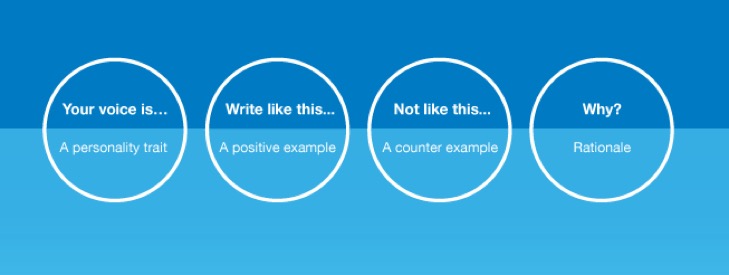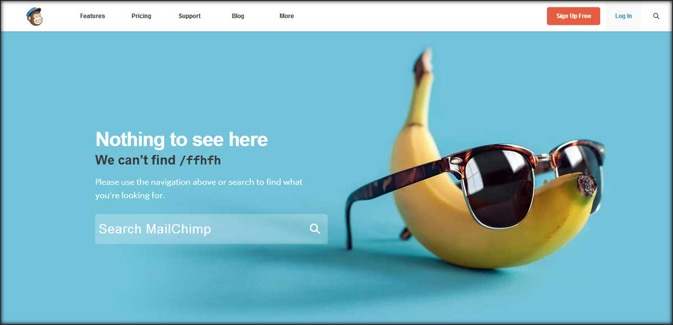Brand equals credibility and reputation. A strong brand voice reflects a clear, direct, and consistent expression of a company’s unique positioning and personality. And the written word is an integral component of that expression. The words we use when we communicate with our audiences – customers, partners, influencers, and prospects – can, directly and indirectly, affect how they view us and interact with us. As a technical communicator, your goal is to convey the distinctive qualities that make up your company’s brand through your writing. How you say something is just as important as what you say. Communicating your messages clearly in a consistent tone and voice helps you enhance the brand and the company’s value in both the marketplace and in the community. There are many reasons to speak in a strong brand voice. For example, consider these:
1. It's the face behind your brand
Your tone of voice is your brand’s identity. It’s an expression of your company’s values and way of thinking. Your customers cannot see your body language through their computers or mobile device, so the tone of voice in your content is a major contributor to what your brand reveals.
2. It's what makes you different from the rest
Consider taking an enthusiastic approach to a rather matter-of-fact sentiment: “We apologize, but we are experiencing a problem” can become “Oops! We’re sorry, but we’re experiencing a problem.” The meaning of the message remains the same, but adding a few words can transform your message from a classic formal tone to a more friendly one. A compelling, authentic voice describes what your customers can expect from every single encounter, uniquely differentiated from your competitors. Your audience hears a unique message in a refreshing style that is different from what they hear from the competition.
3. It builds trust, a force multiplier
Tone of voice is like personality. Because something familiar requires little effort to process mentally, we are more likely to feel at ease around it. When you present your content in a consistent tone, your customers feel like they’re getting to know the brand, bringing with it a sense of trust and familiarity.
Brand essence – the foundation for great content
Your brand voice is developed by understanding your audience, delivering value from your offering, and conveying your organization’s core values. Ask yourself how your brand should show itself in the content you produce. Is there a specific way you talk about your company or the products and services it offers? Getting that information is critical to making sure you’re representing the business correctly. To ensure your brand voice is solid and clear, ask yourself: What makes our brand persona unique? What’s the backstory? And why is our brand so passionate about what it does? Answering these questions provides a solid foundation to continue building upon.
The Golden Circle: What – How – Why? |
Language is your hero
To deliver great content, you must focus on more than just relevance and usefulness. You must pay attention to the language itself, to make sure that your content is findable, readable, and engaging.
Great content + Powerful language = Impact
From shifts in focus, attention span, and approach, compelling content is largely replacing personal interactions as a way to build relationships. Increasingly, a company’s success or failure swivels on the quality of its content. All forms of content, regardless of whether they come from marketing, technical documentation, blogs, eBooks, support, or any other department, have evolved into a powerful tool for engaging customers. To build relationships with your customers, it’s not enough if your content is just readable; it must also create an emotional connection with your audience that is necessary to foster engagement.
It’s obvious that reading a user guide is not as exciting as watching an episode of Stranger Things on Netflix, but technical content that is engaging enough to hold a person’s attention provides a clear reward for the time spent consuming the content. Writing technical documentation doesn’t necessarily mean writing pages of boring content filled with technical terms and explaining complex topics in ways that only experts understand – it’s just a mindset shift to think and write technical content in a language that is interesting to read. A simple example can be using personal pronouns: Do you speak to your audience directly, by using “you” and “yours?” Or do you use a robotic style that addresses “customers” or “users”? When you aim to transform your content from a classic formal style to a more customer-centric one that focuses on what the product does for the end user, you’ll notice that your content becomes less boring.
The power of storytelling
We’ve all seen how storytelling has been adopted by content marketing teams as a perfect way to engage new customers. Have you ever considered how storytelling can enrich tech docs and make people like reading them? Though storytelling is not suitable for all audiences, companies are considering using it for end-user products that require explanation. Storytelling in technical content can be used to facilitate the flow of information. Of course, the overhead for this is greater than writing in a more traditional style, but it pays off in the form of higher customer satisfaction.
Go formal or keep it casual?
Writing in a way that reflects how you speak doesn’t necessarily mean your language must be very casual; you can still apply the same manners, considerations, and standards, just without the formal terminology. It’s a shift in strategy that relates to your target audience.
A formal traditional message: “We added the Allow CarPlay setting to prevent application notifications from being shown when CarPlay is active on the enrolled device.”
The new normal – casual and engaging: “Worried about distracted driving? You can now prevent application notifications from showing in CarPlay mode for all your iOS 12 devices with the Allow CarPlay setting.”
At the core of every piece of writing is the “message”– the information we’re trying to communicate to our users. In both messages, we communicate that the Allow CarPlay setting prevents an application notification from being shown in CarPlay. What’s different is the way we are connecting with the audience with a simple variation in the tone of voice. Now, which of these versions of the same message would work best? It depends on the brand and the users.
For example, Mailchimp is a great example for a consistent brand voice. The homepage feels like a one-on-one conversation. You are approached with a direct tone and assured that you will find the solution you need. It is important to always identify who you’re talking to. Knowing who you’re trying to reach will set the standard for your voice and tone. Another good example is Vimeo. Vimeo’s tone of voice is humorous and intelligently persuasive, which reflects well on the brand. Innocent’s tone of voice is laid back, playful and humorous across all of its platforms. Each brand can have its own identity and set the rules for engagement.
Keep it jargon-free
There is nothing worse than showing up at a party and not knowing anyone there. That’s exactly how people feel when they read something filled with jargon and unfamiliar language. As writers, sometimes we forget that not everyone understands our content quite like we do. When people don’t understand what they’re reading, they immediately lose interest. It’s important that we communicate in a simple yet passionate and energetic manner, and not appear dull and understated.
I am sometimes tempted to spice up my writing with bigger words and complex statements because I think it sounds smarter. It actually doesn’t. It only confuses the message. Plain language is for everyone, even experts. Using simple language inspires more of a sense of trust with your audience. This calls for a different tone of voice: a voice that is simple and easy to understand. And writing in simple, plain language does not mean dumbing down your content. Using simpler and fewer words wherever possible increases readability dramatically.
Rules of grammar
Changes in language often take a while to become part of what's considered formal English. Much of this depends on the audience. For example, there is the general belief – although without historical or grammatical foundation – that it is incorrect to begin a sentence with a conjunction such as and, but or so. And even the most liberal grammarians have followed this practice. As with many long-lasting grammar rules, some people feel strongly about this one. But in the interest of clarity and readability, it’s acceptable to ease this rule.
“But since writing is communication, clarity can only be a virtue. And although there is no substitute for merit in writing, clarity comes closest to being one.” - William Strunk Jr. & E. B. White, The Elements of Style, 1959
In general, grammar exists to help us communicate clear and meaningful messages. Many grammatical rules are important and should never be violated. But some grammar rules are worth breaking if you have a good reason. The rules that you can violate depend on the context, the target audience, and the tone of voice.
Nielsen Norman Group gives clear examples of how we can best break the grammar rules to increase clarity.
Funny content, serious business – use humor sparingly
Humor is a great way to grab people's attention and stand out from the competition. However, if your humor falls flat with people and they don't get the joke, it can be a disaster for your brand. Humor can play a major role in setting your brand apart and help you show off your personality, but only if you do it right. First, ask yourself if humor is suitable for your brand. If it is, be mindful of a few aspects:
- One size does not fit all: What’s funny to one group of people may not be funny to another.
- Keep it relevantand specific to your target audience and situation: For instance, when a user experiences a sudden, unavoidable system failure, or loss of data, a cute and informal tone of voice isn’t funny — it only adds yet another layer of frustration.
- Trying to achieve the universal chuckle? You’ll suffer with translation: If you are looking to go global with your content, make sure your translation partner is committed to preserving the inherent humor across all target languages.
- Be natural: Don’t frustrate your audience. Customers want to know how your product can change their lives, so make your humor relatable to their lives and even their pain points.
Figure 1: Creative 404 error message by MailChimp
Writers' workshop – change the tone of your content
After you’ve learned that your content needs to evolve with your audience, several steps are required to manage a shift in tone. Rather than deciding on a tone of voice on your own, and then expecting the rest of the company to use it unquestioningly, involve your tribe in the early stages of planning. Get your contributors on board with the new strategy and pull off a graceful transition away from the old tone. Here are a few guidelines for changing your content’s tone:
Define your rules of engagement
Every business needs to have a strong brand voice from the outset. For example, does your business see itself as warm and friendly, or does it want to come across as more formal? The most successful businesses have a crystal-clear idea of who they are; they know exactly what audience they want to target with their communication and how they want to engage with them. In addition, businesses are aware that potential clients will be basing their first impressions on the quality and tone of their content. You need to understand what your company wants and what it can tolerate. For example, can your brand relax into addressing the reader directly (“you”) and using the first person (“we”)? Does your brand use humor to engage with customers and, if so, what kind of humor? Is there a need to adjust your content persona(s)? The answers to these questions can help you understand if your current brand voice is falling flat with users and, if so, you can soon begin plotting the direction your tone should be moving towards in the future.
Tone of voice content model
Assessing your current tone and guidelines can help you, in turn, better understand how to position your brand in the marketplace. And collaborating with your team to craft and communicate these ideas can help everyone see your vision. I’ve found the model in Figure 2 to be one of the most effective ways of writing tone-of-voice guidelines. It’s both easy to digest and memorable. It focuses on the personality behind the voice rather than the specifics of grammar.

Figure 2: Tone and voice governance model
Source: https://gathercontent.com/blog/a-simple-tool-to-guide-tone-of-voice
While fleshing out the tone of voice table, consider the core aspects of your brand. What are some personality attributes that could sum up those aspects? Boil down the values of your business into a few keywords. These can be adjectives such as intelligent, professional, innovative. Can you find some examples that illustrate that trait? Adding a few examples of phrases that you like versus those you don’t with a clear rationale can help writers understand the difference before applying the guidelines.
Here’s how VMware uses a few provocative words that capture the essence of our brand and bring the brand to life. We call ourselves Bold, Simple, Trusted and Innovative. These are our four core brand attributes. We clearly define what each of these attributes means and what they don’t.
For example:
Bold is: Enthusiastic Energetic Strong Confident Passionate | Bold is not: Aggressive Loud Loud or Shouting Fanatical Controversial |
The emphasis of various brand attributes also depends on the type of communication vehicle. For example, when writing a technical whitepaper, we emphasize Simple and Trusted attributes. A direct marketing campaign, on the other hand, exhibits the Bold and Innovative voice attributes. Creating a simple voice and tone table with short and helpful tips can help anyone who writes for your brand.
Many writers, one brand – a governance model
Implementing a new tone across all of your content is a slow and steady process. If every piece of your content went from sleek and serious one day to joyful and friendly the next, that would confuse the heck out of your audience! At the same time, creating continuity with previous content is always challenging, especially if you’ve been publishing content for a while. It’s best to start with a small microcopy – first, identify the articles you choose to repurpose. Changes to tone can be introduced over weeks, and you don’t need to implement everything at once. That said, there needs to be someone responsible for ensuring that the tone of voice is implemented across all of your relevant content areas. Without this, it is very easy for guidelines to be forgotten or lost in the cracks of everyday work life. Brand voice caretakers must maintain and manage brand voice consistency. Not only will this ensure your brand voice is successfully upheld, but it will be nurtured and evolve in tandem with business growth.
Brand voice plays a vital role in making sure your message cuts through the noise and makes a lasting impression on potential customers. Ultimately, no matter how you identify and define your voice, you should ensure you are always communicating clearly what your brand is, what you are doing, and the message you want to deliver. Your brand voice has the potential to be your most valuable business asset – so put in the time and effort it deserves.


